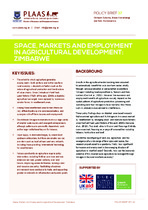| dc.contributor.author | Sukume, Chrispen | |
| dc.contributor.author | Mavedzenge, Blasio | |
| dc.contributor.author | Murimbarima, Felix | |
| dc.date.accessioned | 2019-02-26T09:18:58Z | |
| dc.date.available | 2019-02-26T09:18:58Z | |
| dc.date.issued | 2015 | |
| dc.identifier.citation | Sukume, C. et al. (2015). Space, markets and employment in agricultural development: Zimbabwe. Policy Brief 37, Bellville: Institute for Poverty, Land and Agrarian Studies, University of the Western Cape | en_US |
| dc.identifier.uri | http://hdl.handle.net/10566/4292 | |
| dc.description.abstract | Growth in the agricultural sector has long been assumed
to automatically benefit the rural non-farm sector, chiefly
through various production or consumption expenditure
‘linkages’ including local expenditure by farmers and their
workers (Davis et al., 2002). However, the economic and
employment benefits of agriculture crucially depend on the
spatial patterns of agricultural production, processing and
marketing (and their linkages to local markets). How these
work in Zimbabwe is examined in what follows.
These policy findings draw on detailed, area-based research
that examined agriculture and its linkages in two areas marked
by ‘resettlement’ by emerging small- and medium-scale farmers
since the Fast-Track Land Reform of the early 2000s (Sukume
et al., 2015). Two study sites in Mvurwi and Masvingo Districts
were examined, focusing on a range of commodities including
tobacco, horticulture and beef. | en_US |
| dc.language.iso | en | en_US |
| dc.publisher | Institute for Poverty, Land and Agrarian Studies, University of the Western Cape | en_US |
| dc.relation.ispartofseries | Policy Brief;37 | |
| dc.subject | Markets | en_US |
| dc.subject | Employment | en_US |
| dc.subject | Agricultural development | en_US |
| dc.subject | Zimbabwe | en_US |
| dc.subject | South Africa | en_US |
| dc.title | Space, markets and employment in agricultural development: Zimbabwe | en_US |
| dc.type | Other | en_US |

